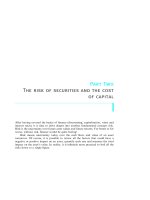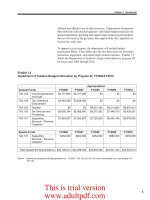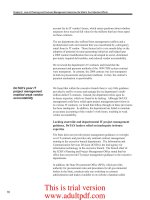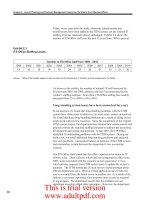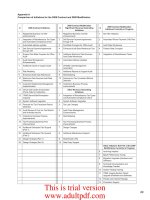Corporate Finance Chapter 2 Financial Statements, Taxes and Cash Flow
Bạn đang xem bản rút gọn của tài liệu. Xem và tải ngay bản đầy đủ của tài liệu tại đây (1.38 MB, 37 trang )
CHAPTER 2
F I N A N C I A L S T A T E M E N T S A N A LY S I S A N D F I N A N C I A L M O D E L S
Copyright © 2018 McGraw-Hill Education. All rights reserved. No reproduction or distribution without the prior written consent of McGraw-Hill Education.
3-1
KEY CONCEPTS AND SKILLS
• Understand the information provided by financial
statements
• Differentiate between book and market values
• Know the difference between average and
marginal tax rates
• Grasp the difference between accounting income
and cash flow
• Calculate a firm’s cash flow
Copyright © 2018 McGraw-Hill Education. All rights reserved. No reproduction or distribution without the prior written consent of McGraw-Hill Education.
2-2
CHAPTER OUTLINE
2.1 The Balance Sheet
2.2 The Income Statement
2.3 Taxes
2.4 Net Working Capital
2.5 Cash Flow of the Firm
2.6 The Accounting Statement of Cash
Flows
Copyright © 2018 McGraw-Hill Education. All rights reserved. No reproduction or distribution without the prior written consent of McGraw-Hill Education.
2-3
2.1 THE BALANCE SHEET
An accountant’s snapshot of the firm’s
accounting value at a specific point in time
The Balance Sheet Identity is:
Assets ≡ Liabilities + Stockholders’ Equity
Copyright © 2018 McGraw-Hill Education. All rights reserved. No reproduction or distribution without the prior written consent of McGraw-Hill Education.
2-4
TAKE NOTICE!
(ON THE FOLLOWING BALANCE SHEET)
• Assets exactly equal liabilities + equity
• Assets are listed in order of liquidity
• The amount of time it would take to convert them to cash
in an operating business
• Obviously cash and A/R are more liquid than
property plant and equipment
• Liabilities are listed in the order in which they
come due
Copyright © 2018 McGraw-Hill Education. All rights reserved. No reproduction or distribution without the prior written consent of McGraw-Hill Education.
2-5
U.S. COMPOSITE CORPORATION
BALANCE SHEET (IN $ MILLIONS)
Copyright © 2018 McGraw-Hill Education. All rights reserved. No reproduction or distribution without the prior written consent of McGraw-Hill Education.
2-6
BALANCE SHEET ANALYSIS
•
When analyzing a balance sheet, the
Finance Manager should be aware of
three concerns:
1. Accounting liquidity
2. Debt versus equity
3. Value versus cost
Copyright © 2018 McGraw-Hill Education. All rights reserved. No reproduction or distribution without the prior written consent of McGraw-Hill Education.
2-7
ACCOUNTING LIQUIDITY
• Refers to the ease and quickness with which
assets can be converted to cash—without a
significant loss in value
• Current assets are the most liquid
• Some fixed assets are intangible
• The more liquid a firm’s assets, the less likely the
firm is to experience problems meeting shortterm obligations
• Liquid assets frequently have lower rates of
return than fixed assets
Copyright © 2018 McGraw-Hill Education. All rights reserved. No reproduction or distribution without the prior written consent of McGraw-Hill Education.
2-8
DEBT VERSUS EQUITY
• Creditors generally receive the first claim on the
firm’s cash flow.
• Shareholders’ equity is the residual difference
between assets and liabilities.
• Debt and equity have different costs; the
relationship between them has an impact on the
firm’s profitability.
Copyright © 2018 McGraw-Hill Education. All rights reserved. No reproduction or distribution without the prior written consent of McGraw-Hill Education.
2-9
VALUE VERSUS COST
• Under Generally Accepted Accounting Principles
(GAAP), financial statements of firms in the U.S.
carry assets at historical cost.
• Market value is the price at which the assets,
liabilities, and equity could actually be bought or
sold, which is a completely different concept from
historical cost.
Copyright © 2018 McGraw-Hill Education. All rights reserved. No reproduction or distribution without the prior written consent of McGraw-Hill Education.
2-10
2.2 THE INCOME STATEMENT
• Measures financial performance over a
specific period of time
• The accounting definition of income is:
Revenue – Expenses ≡ Income
Copyright © 2018 McGraw-Hill Education. All rights reserved. No reproduction or distribution without the prior written consent of McGraw-Hill Education.
2-11
U.S.C.C. INCOME STATEMENT 2017
OPERATIONS SECTION
(IN $ MILLIONS)
The operations
section of the
income statement
reports the firm’s
revenues and
expenses from
principal
operations.
Total operating revenues
Cost of goods sold
Selling, general, and administrative expenses
Depreciation
Operating income
Other income
Earnings before interest and taxes
Interest expense
Pretax income
Taxes
Current: $71
Deferred: $13
Net income
Addition to retained earnings
Dividends:
$2,262
1,655
327
90
$190
29
$219
49
$170
84
$86
$43
$43
Copyright © 2018 McGraw-Hill Education. All rights reserved. No reproduction or distribution without the prior written consent of McGraw-Hill Education.
2-12
U.S.C.C. INCOME STATEMENT 2017
NON-OPERATING SECTION
(IN $ MILLIONS)
The non-operating
section of the
income statement
includes all
financing costs,
such as interest
expense.
Total operating revenues
Cost of goods sold
Selling, general, and administrative expenses
Depreciation
Operating income
Other income
Earnings before interest and taxes
Interest expense
Pretax income
Taxes
Current: $71
Deferred: $13
Net income
Addition to retained earnings:
Dividends:
$2,262
1,655
327
90
$190
29
$219
49
$170
84
$86
$43
$43
Copyright © 2018 McGraw-Hill Education. All rights reserved. No reproduction or distribution without the prior written consent of McGraw-Hill Education.
2-13
U.S.C.C. INCOME STATEMENT 2017
NET INCOME
(IN $ MILLIONS)
Net income is the
“bottom line.”
Total operating revenues
Cost of goods sold
Selling, general, and administrative expenses
Depreciation
Operating income
Other income
Earnings before interest and taxes
Interest expense
Pretax income
Taxes
Current: $71
Deferred: $13
Net income
Retained earnings:
Dividends:
$2,262
1,655
327
90
$190
29
$219
49
$170
84
$86
$43
$43
Copyright © 2018 McGraw-Hill Education. All rights reserved. No reproduction or distribution without the prior written consent of McGraw-Hill Education.
2-14
INCOME STATEMENT ANALYSIS
•
There are three things to keep in mind
when analyzing an income statement:
1. Generally Accepted Accounting Principles
(GAAP)
2. Noncash Items
3. Time and Costs
Copyright © 2018 McGraw-Hill Education. All rights reserved. No reproduction or distribution without the prior written consent of McGraw-Hill Education.
2-15
GAAP
•
•
The matching principal of GAAP dictates that
revenues be matched with expenses.
Thus, income and expenses are reported when
earned or incurred, even though no cash flow
may have occurred.
Copyright © 2018 McGraw-Hill Education. All rights reserved. No reproduction or distribution without the prior written consent of McGraw-Hill Education.
2-16
NONCASH ITEMS
• Depreciation is the most apparent noncash item. No firm ever writes a check for
“depreciation.”
• Other noncash accounts include
uncollected sales on account, unpaid
purchases on account and deferred taxes,
none of which represent a cash flow.
Thus, net income does not equal cash
flow
Copyright © 2018 McGraw-Hill Education. All rights reserved. No reproduction or distribution without the prior written consent of McGraw-Hill Education.
2-17
TIME AND COSTS
• Think of the future as having two parts:
short run and long run
• In the short run some costs are fixed and
others variable:
• In the short run equipment and commitments
are fixed
• Production can only be varied by altering labor
and materials
• In the long run all costs are variable
Copyright © 2018 McGraw-Hill Education. All rights reserved. No reproduction or distribution without the prior written consent of McGraw-Hill Education.
2-18
COSTS AND PURPOSE
• Financial accountants do not distinguish
between variable costs and fixed costs
• Accounting costs are usually treated as
period or product costs
•
Product Costs: Total production costs
•
•
i.e., raw materials, direct labor, manufacturing
overhead
Period Costs: Costs allocated to a time period
•
•
i.e., selling, general and administrative costs
Such as accountant salaries, office supplies
Copyright © 2018 McGraw-Hill Education. All rights reserved. No reproduction or distribution without the prior written consent of McGraw-Hill Education.
2-19
2.3 TAXES
• Taxes impact income; important to financial
decisions
• Taxes come from various sources:
•
Federal, state, excise
• Taxes are always changing
• Marginal vs. average tax rates
•
•
Marginal – the percentage paid on the next dollar
earned
Average = the tax bill / taxable income
• Financial decisions are incremental; applicable
tax rate is the marginal rate
• Other taxes
Copyright © 2018 McGraw-Hill Education. All rights reserved. No reproduction or distribution without the prior written consent of McGraw-Hill Education.
2-20
MARGINAL VERSUS AVERAGE TAX RATES
• Suppose your firm earns $4 million in taxable
income:
• What is the firm’s tax liability?
• What is the average tax rate?
• What is the marginal tax rate?
• If you are considering a project that will increase
the firm’s taxable income by $1 million, what tax
rate should you use in your analysis?
Copyright © 2018 McGraw-Hill Education. All rights reserved. No reproduction or distribution without the prior written consent of McGraw-Hill Education.
2-21
2.4 NET WORKING CAPITAL
• Net Working Capital ≡
Current Assets – Current Liabilities
• NWC usually grows with the firm
Copyright © 2018 McGraw-Hill Education. All rights reserved. No reproduction or distribution without the prior written consent of McGraw-Hill Education.
2-22
U.S.C.C. BALANCE SHEET
NET WORKING CAPITAL
$252m = $707- $455
2017
Current assets:
Cash and equivalents
Accounts receivable
Inventories
Total current assets
$198
294
269
$761
2016
$157
270
280
Current Liabilities:
Accounts payable
Total current liabilities
2016
$486
$455
$486
$455
$707
Fixed assets:
Property, plant, and equipment
$1,423 $1,274
Less accumulated depreciation
(550)
(460
Net property, plant, and equipment
873
814
Intangible assets and other
245
221
Total fixed assets
$1,118 $1,035
$275m = $761m- $486m
2017
Long-term liabilities:
Deferred taxes
Long-term debt
Total long-term liabilities
Here we see NWC grow
$117 to $104
471
458
$275 million in 2017 from
$588
$562
$252 million in 2016.
Stockholder's equity:
Preferred stock
$39
$39
$23
million
Common stock ($1 par value)
55
32
This increase of $23 million is
an investment of the firm.
Copyright © 2018 McGraw-Hill Education. All rights reserved. No reproduction or distribution without the prior written consent of McGraw-Hill Education.
2-23
2.5 CASH FLOW OF THE FIRM
• In finance, the most important item that can
be extracted from financial statements is
the actual cash flow of the firm.
• Cash flow received from the firm’s assets
must equal the cash flows to the firm’s
creditors and stockholders.
CF(A)≡ CF(B) + CF(S)
• In other words, the cash generated by
assets enables the firm to pay its debts and
provide a return to shareholders.
• Accounting cash flow and financial cash flow
are not necessarily equal.
Copyright © 2018 McGraw-Hill Education. All rights reserved. No reproduction or distribution without the prior written consent of McGraw-Hill Education.
2-24
U.S.C.C. FINANCIAL CASH FLOW:
OCF
Cash Flow of the Firm
Operating cash flow
(Earnings before interest and taxes
plus depreciation minus taxes)
Capital spending
(Acquisitions of fixed assets
minus sales of fixed assets)
Additions to net working capital
Total
Cash Flow of Investors in the Firm
Debt
(Interest plus retirement of debt
minus long-term debt financing)
Equity
(Dividends plus repurchase of
equity minus new equity financing)
Total
$238
Operating Cash Flow:
EBIT
-173
-23
$42
$219
Depreciation
$90
Current Taxes -$71
OCF
$238
$36
6
$42
Copyright © 2018 McGraw-Hill Education. All rights reserved. No reproduction or distribution without the prior written consent of McGraw-Hill Education.
2-25

